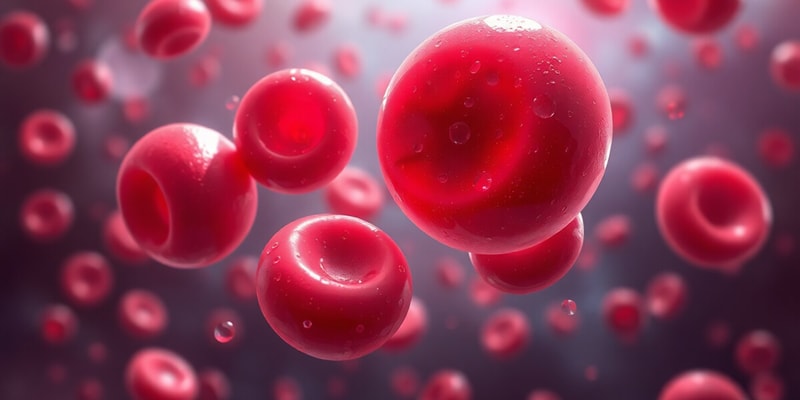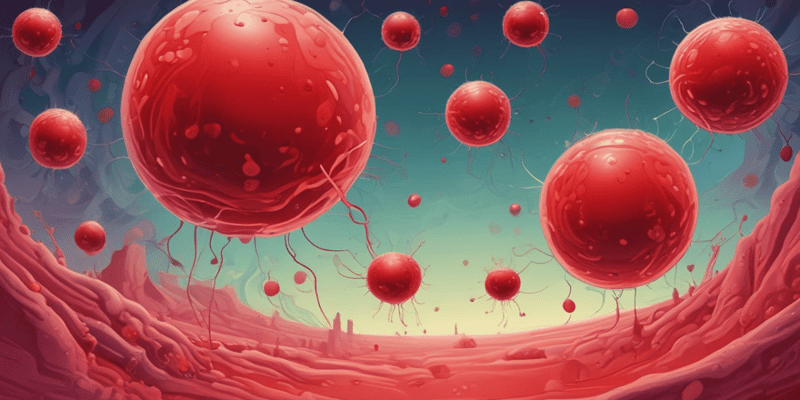Podcast Beta
Questions and Answers
What characterizes iron deficiency anemia?
Which measurement indicates the proportion of cells in blood?
Which of the following symptoms is NOT commonly associated with anemia?
The oxygen-carrying capacity of the blood primarily reflects which measurement?
Signup and view all the answers
What can severe anemia potentially lead to if the oxygen supply to the heart is reduced?
Signup and view all the answers
In anemia, what causes the inflammation and ulceration of the digestive tract?
Signup and view all the answers
Which factor does NOT contribute to the different types of anemia?
Signup and view all the answers
What is indicated by an elevated erythrocyte sedimentation rate (ESR)?
Signup and view all the answers
What characterizes acute lymphocytic leukemia (ALL) in children?
Signup and view all the answers
Which type of leukocyte is least abundant in a healthy adult's blood?
Signup and view all the answers
What is the primary consequence of the uncontrolled proliferation of leukemic cells in the bone marrow?
Signup and view all the answers
Which population is at higher risk for developing leukemia due to chromosomal abnormalities?
Signup and view all the answers
What is a defining characteristic of blast cells found in leukemia?
Signup and view all the answers
What is the primary genetic inheritance pattern of sickle cell anemia?
Signup and view all the answers
Which of the following conditions is NOT a potential cause of hemolytic anemia?
Signup and view all the answers
What is the primary abnormality in the red blood cells of individuals with sickle cell anemia?
Signup and view all the answers
How can sickle cell trait be identified in an individual?
Signup and view all the answers
What role does hydroxyurea play in the treatment of sickle cell anemia?
Signup and view all the answers
What additional clinical sign is associated with a diagnosis of sickle cell anemia in children over one year of age?
Signup and view all the answers
Which of the following is a consequence of sickle cell anemia during a sickling crisis?
Signup and view all the answers
What type of blood test is primarily used for prenatal diagnosis of sickle cell anemia?
Signup and view all the answers
Which of the following statements is true regarding individuals with sickle cell trait?
Signup and view all the answers
What is a significant complication of both sickle cell anemia and thalassemia?
Signup and view all the answers
What is one of the most common signs of excessive bleeding associated with hematomas?
Signup and view all the answers
Which clotting disorder is characterized by a deficiency of coagulation factor VIII?
Signup and view all the answers
In disseminated intravascular coagulation (DIC), what is the initial problem that leads to excessive bleeding?
Signup and view all the answers
What primary abnormality characterizes Hemophilia B?
Signup and view all the answers
What might 'hemarthrosis' indicate in a patient with a bleeding disorder?
Signup and view all the answers
Which symptom is specifically associated with hemoptysis in bleeding disorders?
Signup and view all the answers
Which group of individuals is most likely to be carriers of hemophilia A due to its genetic transmission?
Signup and view all the answers
What indicates a possible severe underlying bleeding disorder in a patient?
Signup and view all the answers
Which manifestation is least likely to be observed in a patient with severe hemophilia?
Signup and view all the answers
What type of bleeding might indicate digestive tract involvement in patients with bleeding disorders?
Signup and view all the answers
What is the primary focus of treatment in Polycythemia Vera?
Signup and view all the answers
Which of the following are complications associated with treatments for Polycythemia Vera?
Signup and view all the answers
What triggers the first step of hemostasis?
Signup and view all the answers
What is essential for the synthesis of most clotting factors in the liver?
Signup and view all the answers
Which condition is not a cause of abnormal bleeding mentioned?
Signup and view all the answers
Which of these processes is part of hemostasis?
Signup and view all the answers
What can occur due to an incompatible blood transfusion?
Signup and view all the answers
Calcium ions are necessary for which part of the blood-clotting process?
Signup and view all the answers
During a blood vessel injury, which is the first physiological response?
Signup and view all the answers
What can result from Rh incompatibility between a mother and her fetus?
Signup and view all the answers
Study Notes
Erythrocytes
- Normal values for males are 4.9 - 5.9 million RBCs/mm³ and hemoglobin 13.5 - 18 g/100 ml
- Normal values for females are 4.2 - 5.2 million RBCs/mm³ and hemoglobin 12 - 16 g/100 ml
- Reticulocytes may reveal inadequate production of RBCs
- Hematocrit measures the proportion of cells in blood and is normally 35 - 50%
- Erythrocyte sedimentation rate (ESR) is a test that measures how quickly red blood cells settle at the bottom of a test tube, helping to diagnose infection or inflammation
- Mean corpuscular volume (MCV) measures the volume of a red blood cell, which is often used to classify anemias
- Mean corpuscular hemoglobin (MCH) is the average amount of hemoglobin per cell and indicates the oxygen-carrying capacity of the blood
- Blood oxygen saturation is measured using a pulse oximeter
Anemia
- A decrease in hemoglobin, a reduction in the number of erythrocytes, or a combination of the two factors, will lead to anemia
- Anemia leads to a reduction in oxygen transport in the blood
- Anemia leads to a decrease in oxygen-carrying ability of the blood
- Common symptoms associated with anemia include fatigue, pale face, difficulty breathing, and fast heart rate
- Anemia can lead to a decrease in the regeneration of epithelial cells which affects the digestive tract and can lead to ulcers in the mouth, inflamed and cracked lips, and difficulty swallowing.
- Hair and skin may also show signs of degeneration.
- Severe anemia can lead to angina and congestive heart failure.
Types of Anemia
-
Iron Deficiency Anemia
- Caused by insufficient iron and therefore decreased hemoglobin resulting in diminished oxygen transport
- Common in all age groups and is particularly common in pregnant women
-
Pernicious Anemia
- Caused by vitamin B12 deficiency which is also referred to as megaloblastic anemia
-
Aplastic Anemia
- A rare and serious condition where the bone marrow does not produce enough blood cells
- ** Hemolytic Anemia**
- Caused by excessive destruction of RBCs, or hemolysis
- Can be caused by genetic defects affecting the structure of the RBCs, immune reactions, changes in blood chemistry, toxins in the blood, infections such as malaria, transfusion reactions, and blood incompatibility in the neonate.
Hemolytic Anemias
- Sickle Cell Anemia
- This is a genetic disorder caused by a mutation in the hemoglobin gene
- This leads to hemoglobin S (HbS) which crystallizes when deoxygenated resulting in a sickle shape of the red blood cells.
- Individuals with sickle cell anemia typically inherit the sickle cell gene from both parents
- Sickle cell anemia is common amongst people of African and Middle Eastern descent
- Thalassemia
- This is a genetic disorder where the body cannot produce enough hemoglobin
- Similar to sickle cell disease, it is also a genetic disorder and is often found in people of Mediterranean, Asian, and African descent
Sickle Cell Anemia
- Sickle cell anemia is diagnosed through DNA analysis of fetal blood and by finding sickled cells in the blood of children over one year of age
- Sickle cell trait is a condition where less than half of the hemoglobin is the abnormal HbS, and therefore may only become apparent under severe hypoxia
- Treatment focuses on reducing the frequency of crises and prolonging life expectancy, with hydroxyurea being an effective treatment option for many patients
- Bone marrow transplantation may be effective in younger patients
Blood Clotting
- Hemostasis is the process of stopping blood loss and consists of three steps:
- Vasoconstriction of the vessel in response to injury
- Adhesion of thrombocytes to the site of injury followed by platelet plug formation
- Coagulation which involves activating clotting factors present in the blood in response to tissue injury
Blood Clotting Disorders
-
Hemophilia
- This is an inherited sex-linked disorder caused by a deficiency in a clotting factor
- Hemophilia A, or classic hemophilia, is the most common type and is caused by a deficiency in clotting factor VIII
- Hemophilia B is caused by a deficiency in factor IX.
- Hemophilia C is caused by a deficiency in factor XI
- This is transmitted as an X-linked recessive trait and therefore is manifest in men but carried by women who are asymptomatic.
Signs and Symptoms of Hemophilia
- Prolonged or severe bleeding following minor tissue trauma and hematomas are common.
- Spontaneous bleeding into joints (hemarthrosis) may occur.
- Blood may appear in the urine (hematuria) or feces because of bleeding in the kidneys or digestive tract.
Disseminated Intravascular Coagulation (DIC)
- A condition where there is excessive clotting which depletes the body's clotting factors leading to excessive bleeding
Signs and Symptoms of Disseminated Intravascular Coagulation (DIC)
- The most common critical problem is hemorrhage
- Excessive bleeding is present on the skin or mucosa
- Ischemia and multiple infarctions are caused by vascular occlusions
- Multiple organs may fail due to circulatory problems
- Shock may occur
Studying That Suits You
Use AI to generate personalized quizzes and flashcards to suit your learning preferences.
Related Documents
Description
This quiz covers essential concepts related to erythrocytes and anemia, including normal values for red blood cells and hemoglobin in different populations. It also explores tests used to diagnose anemia and the significance of various blood parameters. Test your knowledge and understanding of these important blood components.




